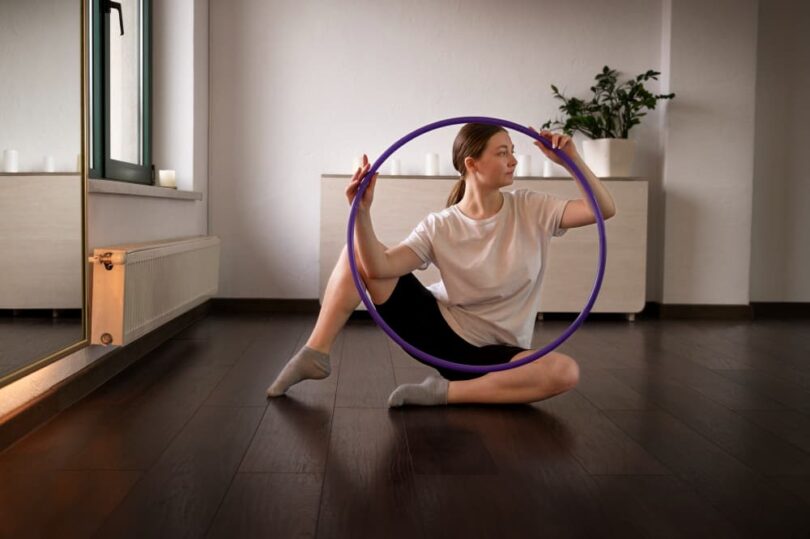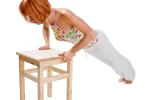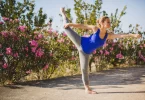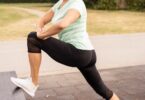Introduction
The yoga wheel is an incredibly versatile prop that can elevate your yoga practice, whether you’re a seasoned yogi or a beginner. This guide will delve into everything you need to know about using a yoga wheel, from its benefits and how to choose the right one to incorporate it into your daily practice with various poses and workouts. By the end of this article, you’ll be ready to roll out your yoga wheel and enhance your flexibility, balance, and strength.
Introduction to Yoga Wheel
What is a Yoga Wheel?
A yoga wheel is a circular-shaped prop designed to assist in yoga practice. Typically made from plastic, cork, or wood, it provides support for challenging poses and helps improve flexibility. Its simple yet effective design makes it a favorite among yogis looking to deepen their stretches and enhance their balance.
Brief History of Yoga Wheel
The yoga wheel is a relatively new addition to the yoga world, gaining popularity in the last decade. Invented to aid backbends and improve spinal flexibility, it quickly became a staple in many yoga studios. Its use has expanded to various poses and exercises, making it a must-have tool for many yoga enthusiasts.
Benefits of Using a Yoga Wheel
Using a yoga wheel offers numerous benefits:
- Improves Flexibility: The wheel helps deepen stretches, allowing for greater flexibility.
- Enhances Balance: It challenges your stability, improving your overall balance.
- Strengthens Core: Many poses using the wheel engage your core muscles.
- Relieves Back Pain: It provides excellent support for backbends, helping to alleviate back pain.
- Aids in Relaxation: The wheel can be used for gentle stretches and relaxation exercises.
Choosing the Right Yoga Wheel
Types of Yoga Wheels
When selecting a yoga wheel, consider the materials and features:
- Materials Used: Yoga wheels can be made from various materials such as plastic, cork, or wood. Each material offers different levels of support and durability.
- Sizes and Dimensions: Yoga wheels come in different sizes. The most common size has a diameter of about 12 inches, which is suitable for most users.
- Features to Look For: Look for wheels with a non-slip surface and adequate padding for comfort.
Top 5 Yoga Wheels on the Market
- UpCircleSeven Dharma: Known for its sturdy build and comfortable padding.
- Acumobility Yoga Wheel: Features unique padding for extra support.
- Shogun Sports Yoga Wheel: Great for beginners due to its supportive structure.
- REEHUT Premium Yoga Wheel: Sweat-resistant and highly durable.
- Chirp Wheel+: Popular for its design, which targets back pain relief.
Getting Started with Yoga Wheel
How to Use a Yoga Wheel
Getting started with a yoga wheel can seem a bit daunting at first, but with some basic techniques and safety tips, you’ll be well on your way to incorporating this versatile tool into your practice.
Basic Techniques
The key to using a yoga wheel effectively is to start with simple exercises to get comfortable with its feel and function.
- Find Your Balance: Sit on the floor with the wheel positioned vertically behind your back. Gently lean back against the wheel, using it to support your spine. This helps you get used to balancing with the wheel.
- Gentle Backbends: From a seated position, slowly roll back, allowing the wheel to move along your spine. This gentle backbend is great for stretching the chest and shoulders.
- Supported Forward Folds: Place the wheel in front of you and fold forward, using the wheel to support your forehead. This helps deepen the stretch without straining your back.
Safety Tips
Safety should always come first when using a yoga wheel. Here are a few tips to keep in mind:
- Start Slow: Don’t rush into advanced poses. Take your time to build strength and flexibility.
- Use a Mat: Always practice on a yoga mat to prevent slipping.
- Listen to Your Body: Stop immediately if you feel pain or discomfort. The goal is to stretch and strengthen, not to cause injury.
Beginner Yoga Wheel Poses
Once you’re comfortable with the basic techniques, you can try beginner yoga wheel poses. These poses are designed to help you build confidence and understand how the wheel can support your practice.
Child’s Pose
The Child’s Pose with a yoga wheel offers a deeper stretch for the back and shoulders. Kneel on the mat, place the wheel in front of you, and extend your arms, resting them on the wheel. Gently push the wheel forward as you lower your chest towards the ground.
Fish Pose
Fish Pose using a yoga wheel is perfect for opening the chest and improving posture. Lie on your back with the wheel positioned under your shoulder blades. Gently arch your back over the wheel, allowing your head to rest back comfortably.
Half Pyramid Pose
This pose helps stretch the hamstrings and calves. Sit with one leg extended and the other bent. Place the wheel under the calf of the extended leg and lean forward, reaching for your foot.
Lizard Lunge
Lizard Lunge with a yoga wheel enhances hip flexibility. From a lunge position, place the wheel under your front thigh. Gently lower your hips towards the ground, using the wheel for support.
Warrior II
Warrior II with a yoga wheel adds a balance challenge. Stand in Warrior II pose with the wheel in front of you. Place your front hand on the wheel for support, ensuring your back leg remains straight.
Crescent Lunge
Crescent Lunge using a yoga wheel improves balance and stretches the hip flexors. From a lunge position, place the wheel under your back knee. Slowly lower your hips, keeping your front knee aligned over your ankle.
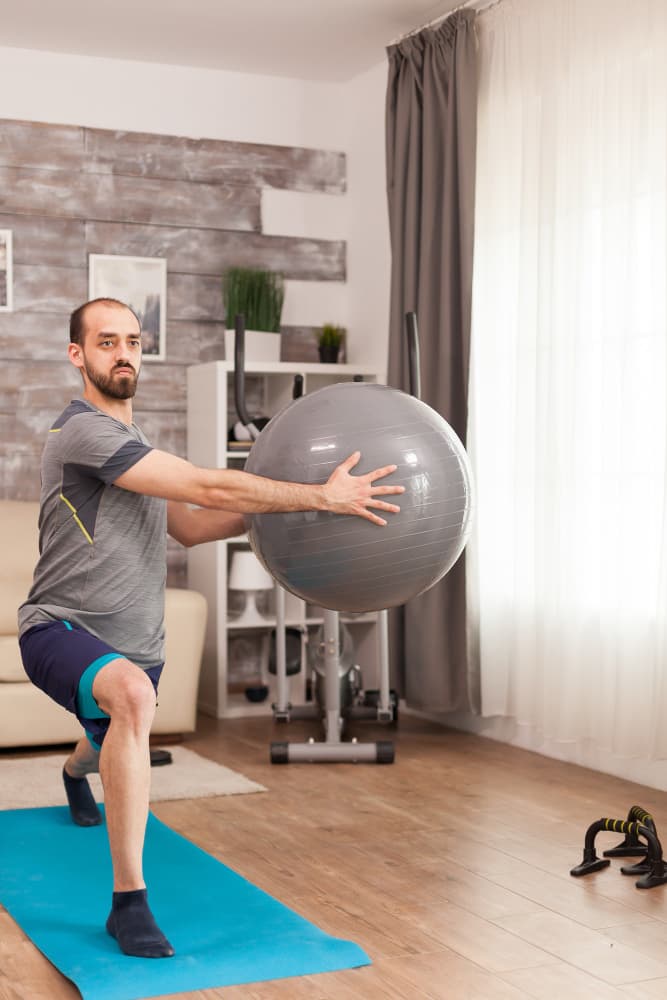
Advanced Yoga Wheel Poses
Heart Opener Wheel Pose
The Heart Opener Wheel Pose is ideal for a deep chest stretch and can help improve your posture significantly. Sit on the mat with the wheel positioned behind you. Lean back over the wheel, opening your chest toward the ceiling. Extend your arms overhead and let your head rest back comfortably. This pose is excellent for opening the front body and relieving shoulder tension.
Supported Plank Pose
The Supported Plank Pose with a yoga wheel engages your core muscles and improves overall body strength. Start in a plank position with your hands on the wheel and your feet on the ground. Keep your body in a straight line from head to heels. Hold this position, ensuring your core is engaged throughout. This poses challenges your stability and strengthens your core.
Hip Flexor Stretch
This stretch targets the hip flexors and helps improve flexibility. Kneel on one knee with the wheel under the opposite thigh. Gently push your hips forward, using the wheel for support. This stretch is great for releasing tightness in the hips, which is especially beneficial if you spend a lot of time sitting.
Wheel-Assisted Bridge Pose
The Wheel-Assist Bridge Pose offers a deeper backbend than the traditional bridge pose. Lie on your back with the wheel under your lower back. Lift your hips, rolling the wheel towards your shoulders to deepen the stretch. This pose not only strengthens your back but also enhances flexibility in your spine.
Supported Backbend
A Supported Backbend with a yoga wheel helps you achieve a deep stretch safely. Position the wheel under your back and gently arch over it, allowing it to support your weight. This pose is fantastic for opening the chest and stretching the abdominal muscles, providing a gentle yet effective backbend.
Rocking Lizard Pose
The Rocking Lizard Pose with a yoga wheel increases hip flexibility. From a lunge position, place the wheel under your front thigh. Slowly lower your hips towards the ground, then gently rock back and forth, allowing the wheel to assist you in deepening the stretch. This pose helps to open the hips and relieve tension.
Rocking Side Bend Stretch
The Rocking Side Bend Stretch helps improve flexibility in the sides of your body. Sit with your legs crossed and place the wheel next to your hip. Lean over the wheel, stretching your side body. Gently rock back and forth, using the wheel to deepen the stretch. This pose is great for lengthening the muscles along your ribcage and improving overall flexibility.
Rocking Squat Pose
The Rocking Squat Pose is a dynamic stretch that engages the lower body. Stand with your feet hip-width apart and place the wheel before you. Squat down, holding onto the wheel for support. Gently rock back and forth, using the wheel to stabilize yourself. This pose strengthens the legs and improves balance.
Supported Uttanasana
Supported Uttanasana, or Standing Forward Bend, with a yoga wheel provides a deeper stretch for the hamstrings and back. Stand with the wheel in front of you and fold forward, placing your hands on the wheel. Use the wheel to support your weight as you deepen the stretch. This pose helps to lengthen the spine and release tension in the back.
Related Article: Apple Fitness Chair Yoga: A Comprehensive Guide
Yoga Wheel Workouts
Full-Body Workouts with Yoga Wheel
Incorporating the yoga wheel into your full-body workouts can add a new dimension to your fitness routine. Here are some routines designed to improve your core strength and flexibility.
Core Strengthening Routine
The yoga wheel is a fantastic tool for core workouts. Start in a plank position with your hands on the wheel and your feet on the ground. Slowly roll the wheel towards your feet and back, engaging your core muscles throughout the movement. This not only strengthens your core but also improves your balance.
Exercises:
- Plank Roll-Outs: Roll the wheel forward and back from a plank position.
- Knee Tucks: In a plank position, place your feet on the wheel and pull your knees towards your chest.
- Ab Wheel Roll-Outs: Kneel on the mat and roll the wheel forward, keeping your core tight.
Flexibility Routine
A flexibility routine using the yoga wheel can help you achieve deeper stretches and improve your overall flexibility.
Exercises:
- Forward Fold: Place the wheel in front of you and fold forward, using the wheel to support your forehead.
- Supported Backbend: Lie on your back with the wheel under your lower back. Lift your hips, rolling the wheel towards your shoulders.
- Hip Flexor Stretch: Kneel on one knee with the wheel under the opposite thigh. Push your hips forward, using the wheel for support.
Specific Workouts
In addition to full-body routines, the yoga wheel can be used for specific workouts targeting back pain relief, balance, and posture improvement.
Back Pain Relief
Using a yoga wheel for back pain relief involves gentle backbends and stretches that help alleviate tension and discomfort in the back.
Exercises:
- Gentle Backbend: Sit on the mat with the wheel behind you. Lean back over the wheel, allowing it to move along your spine.
- Supported Bridge Pose: Lie on your back with the wheel under your lower back. Lift your hips, rolling the wheel towards your shoulders.
- Child’s Pose: Kneel on the mat, place the wheel in front of you, and extend your arms, resting them on the wheel.
Improving Balance
Balance-focused workouts with a yoga wheel challenge your stability and enhance your overall balance.
Exercises:
- Wheel-Assisted Warrior II: Stand in Warrior II pose with the wheel before you. Place your front hand on the wheel for support.
- Crescent Lunge: Place the wheel under your back knee from a lunge position. Lower your hips, keeping your front knee aligned over your ankle.
- Plank Balance: Start in a plank position with your hands on the wheel. Hold this position, engaging your core and maintaining balance.
Enhancing Posture
The yoga wheel improves posture through exercises that open the chest and align the spine.
Exercises:
- Fish Pose: Lie on your back with the wheel positioned under your shoulder blades. Arch your back over the wheel, allowing your head to rest back.
- Heart Opener Wheel Pose: Sit on the mat with the wheel behind you. Lean back over the wheel, opening your chest towards the ceiling.
- Supported Backbend: Position the wheel under your back and gently arch over it, allowing it to support your weight.
Incorporating these yoga wheel workouts into your routine can improve your strength, flexibility, and overall well-being. Always remember to listen to your body and practice safely to prevent injury.
Related Article: Yoga with a High-Intensity Twist
Incorporating Yoga Wheel into Daily Practice
Daily Routine Integration
Adding a yoga wheel to your daily routine can significantly benefit your flexibility, strength, and overall well-being. Here’s how you can easily incorporate it into your morning and evening routines.
Morning Stretch Routine
Starting your day with a few minutes of stretching using a yoga wheel can wake up your muscles and set a positive tone for the rest of the day.
Exercises:
- Child’s Pose: Kneel on your mat and place the wheel before you. Extend your arms and rest them on the wheel. Gently push the wheel forward as you lower your chest towards the ground, stretching your back and shoulders.
- Half Pyramid Pose: Sit with one leg extended and the other bent. Place the wheel under the calf of the extended leg and lean forward, reaching for your foot to stretch your hamstrings and calves.
- Gentle Backbend: Sit on the mat with the wheel behind you. Lean back over the wheel, allowing it to move along your spine, opening your chest and shoulders.
Evening Relaxation Routine
Winding down with a yoga wheel in the evening can help release the day’s tension and prepare your body for a restful night’s sleep.
Exercises:
- Supported Fish Pose: Lie on your back with the wheel positioned under your shoulder blades. Gently arch your back over the wheel, allowing your head to rest comfortably. This pose helps open the chest and relax the shoulders.
- Supported Backbend: Position the wheel under your back and gently arch over it, allowing it to support your weight. This stretch can help release tension in your back and improve spinal flexibility.
- Forward Fold: Place the wheel in front of you and fold forward, using the wheel to support your forehead. This helps to deepen the stretch in your hamstrings and lower back, promoting relaxation.
Yoga Wheel in Different Yoga Styles
The yoga wheel can be incorporated into various yoga styles, adding a new dimension to your practice.
Vinyasa Yoga
In Vinyasa Yoga, the yoga wheel can be used to deepen stretches and add a balance challenge to dynamic flows.
Exercises:
- Wheel-Assisted Warrior II: Stand in Warrior II pose with the wheel before you. Place your front hand on the wheel for support while maintaining the integrity of the pose.
- Crescent Lunge: From a lunge position, place the wheel under your back knee. Lower your hips, keeping your front knee aligned over your ankle, and use the wheel to challenge your balance.
Hatha Yoga
In Hatha Yoga, the yoga wheel can help you hold poses longer and improve alignment, making it beneficial for both beginners and advanced practitioners.
Exercises:
- Supported Plank Pose: Start in a plank position with your hands on the wheel. Hold this position, engaging your core and maintaining balance.
- Heart Opener Wheel Pose: Sit on the mat with the wheel behind you. Lean back over the wheel, opening your chest towards the ceiling, enhancing your posture and flexibility.
Restorative Yoga
The yoga wheel is perfect for Restorative Yoga, providing gentle support and aiding in relaxation.
Exercises:
- Supported Backbend: Position the wheel under your back and gently arch over it, allowing it to support your weight. This pose is great for opening the chest and relieving tension in the back.
- Fish Pose: Lie on your back with the wheel positioned under your shoulder blades. Arch your back over the wheel, allowing your head to rest back comfortably, promoting relaxation and chest opening.
Incorporating the yoga wheel into your daily practice can significantly improve your yoga experience, offering support, enhancing flexibility, and promoting relaxation. By integrating these exercises into your routine, you can enjoy the many benefits that the yoga wheel brings to your practice.
FAQs
Do Yoga Wheels Really Work?
Yes, yoga wheels are effective tools for enhancing your yoga practice. They provide support for difficult poses, help deepen stretches, and improve balance. Many users find that yoga wheels aid in increasing flexibility and relieving back pain, making them a valuable addition to their yoga routine.
What is a Yoga Wheel Used For?
A yoga wheel is used for various purposes in yoga practice. It supports backbends, aids in balance poses, and helps deepen stretches. It can be particularly useful for opening the chest and shoulders, improving spinal flexibility, and providing a gentle massage to the back.
Can a Beginner Use a Yoga Wheel?
Absolutely, beginners can use a yoga wheel. Starting with basic poses and gradually progressing to more advanced exercises allows beginners to safely and effectively incorporate the wheel into their practice. The wheel offers support and helps build confidence in new poses.
What is a Yoga Wheel Pose Good For?
A yoga wheel pose improves flexibility, balance, and core strength. It helps deepen stretches, making it easier to achieve proper alignment and posture. Additionally, yoga wheel poses can aid in relieving tension and pain, especially in the back and shoulders.
Conclusion
The yoga wheel is a versatile and valuable addition to any yoga practice. From beginners to advanced practitioners, this tool can support various poses, improve flexibility, enhance balance, and strengthen the core. By incorporating it into your daily routine, whether through morning stretches or evening relaxation exercises, you can enjoy its numerous benefits.
Starting with basic poses and gradually moving to more advanced exercises ensures that you use the wheel safely and effectively. Moreover, integrating the yoga wheel into different yoga styles like Vinyasa, Hatha, and Restorative Yoga can add variety and depth to your practice.
Remember to listen to your body and practice mindfulness. Whether you’re looking to relieve back pain, improve posture, or simply add a new element to your workouts, the yoga wheel is a fantastic tool to help you achieve your goals. So, roll out your wheel and start experiencing the many advantages it brings to your yoga journey.

